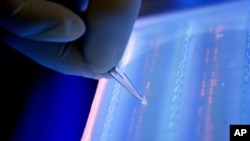One of the researchers who two decades ago put forward the idea of using drug cocktails to treat people infected with the virus that causes AIDS has concluded that combination therapies could cure cancer.
Martin Nowak, Harvard University professor of mathematics and biology, who is also director of the Program for Evolutionary Dynamics, and co-author Ivana Bozic, a postdoctoral fellow in mathematics, published their findings in eLife Journal on Thursday.
Nowak was among researchers who analyzed data on how quickly the AIDS virus mutates against a single drug, a mid-1990s breakthrough that allowed scientists to drive the AIDS virus to virtually undetectable levels in HIV-infected patients by using a combination of antiretroviral drugs — drug cocktails that could turn a lethal disease into a manageable one.
"These calculations led the medical community very quickly to adopt the combination treatment," he said. "And so in some sense, I want to achieve the same for the cancer community."
Today many cancer patients are treated with targeted therapy, drugs that inhibit specific genetic mutations that give rise to the growth and spread of tumors. But some cancers often return, according to Nowak, because they develop resistance to a drug that is trained on a single abnormal gene.
Resistance to more than one drug can also occur, he adds, if they both target the same genetic mutation or if different therapies are used one after the other, giving the cancer time to develop resistance to both drugs.
To figure out a way around the problem, Nowak and colleagues created a computer model, inputting data from Memorial Sloan-Kettering Cancer Center in New York on patients who had died from melanoma, a deadly form of skin cancer.
They also used information on patients from Johns Hopkins Medical Center in Maryland, predicting patients’ response to multiple-drug therapies.
The results showed that the virtual patients, with a variety of cancers, could potentially be cured using two drugs that target different genetic mutations simultaneously.
That gives Nowak hope for the future of cancer treatment and outcomes.
"I’m sure in a few years you will have many success stories when this will gradually lead to a situation where most cancers will be contained in the way that many bacterial infections are treated with antibiotics."
A number of pharmaceutical companies around the world are actively pursuing combination therapies that Nowak hopes will revolutionize the treatment of cancer in much the same way that antiretroviral drugs tamed HIV.
Martin Nowak, Harvard University professor of mathematics and biology, who is also director of the Program for Evolutionary Dynamics, and co-author Ivana Bozic, a postdoctoral fellow in mathematics, published their findings in eLife Journal on Thursday.
Nowak was among researchers who analyzed data on how quickly the AIDS virus mutates against a single drug, a mid-1990s breakthrough that allowed scientists to drive the AIDS virus to virtually undetectable levels in HIV-infected patients by using a combination of antiretroviral drugs — drug cocktails that could turn a lethal disease into a manageable one.
"These calculations led the medical community very quickly to adopt the combination treatment," he said. "And so in some sense, I want to achieve the same for the cancer community."
Today many cancer patients are treated with targeted therapy, drugs that inhibit specific genetic mutations that give rise to the growth and spread of tumors. But some cancers often return, according to Nowak, because they develop resistance to a drug that is trained on a single abnormal gene.
Resistance to more than one drug can also occur, he adds, if they both target the same genetic mutation or if different therapies are used one after the other, giving the cancer time to develop resistance to both drugs.
To figure out a way around the problem, Nowak and colleagues created a computer model, inputting data from Memorial Sloan-Kettering Cancer Center in New York on patients who had died from melanoma, a deadly form of skin cancer.
They also used information on patients from Johns Hopkins Medical Center in Maryland, predicting patients’ response to multiple-drug therapies.
The results showed that the virtual patients, with a variety of cancers, could potentially be cured using two drugs that target different genetic mutations simultaneously.
That gives Nowak hope for the future of cancer treatment and outcomes.
"I’m sure in a few years you will have many success stories when this will gradually lead to a situation where most cancers will be contained in the way that many bacterial infections are treated with antibiotics."
A number of pharmaceutical companies around the world are actively pursuing combination therapies that Nowak hopes will revolutionize the treatment of cancer in much the same way that antiretroviral drugs tamed HIV.








